- Merc’s AMG SL takes on the 911 Turbo
- Two fiercely powerful drop-tops
- Which one takes the crown?
Merc’s latest SL is the sportiest one yet, but it must still excel as a cruiser. That puts the new Merc up against the definitive sporty cruiser: the 911 Turbo Cabrio. How does the Merc fare against the
Pre-flight briefing: Mercedes-AMG SL63
Why is it here?
Because the 911 can’t keep winning everything, can it? Can it? The AMG GT Roadster is no more, and the C- and E-Class convertibles will merge to become the CLE, so Mercedes could not afford to also lose the SL. It’s big on revenue, coolness and brand image, especially in SL63 form. This time, though, don’t expect a V12 spin-off or a Black Series over-achiever.
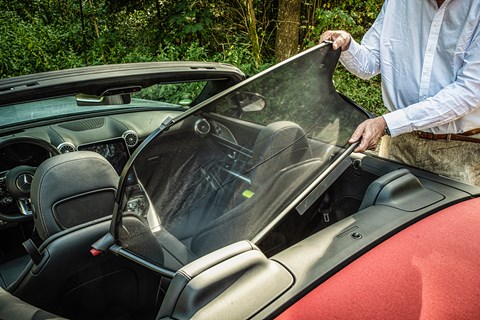
Any clever stuff?
Lots. Like the fully digitised cabin complete with Tesla-style central monitor. Plus the aluminium architecture, clever bi-level aero aids, four-wheel drive and rear-wheel steering. The variety within AMG Driving Dynamics would confuse even a pro. And then there’s the power-operated canvas roof, bringing back fond memories of previous SL generations. Pity about the wind deflector, a clumsy manual affair, which really doesn’t feel appropriate for a car priced over £100k.
Which version is this?
The top-spec SL63. There are three power levels – 43, 55 and 63 – and each is available with at least two spec levels. Entry price for the least fancy (but still pretty classy) SL is £108,030. That gets you a 43 Premium, with rear-wheel drive and mild-hybrid powertrain. A plug-in hybrid with a 200bhp e-motor is rumoured to be in the pipeline.
Read our Mercedes-AMG SL review
Pre-flight briefing: Porsche 911 Turbo Cabriolet
Why is it here?
Because the success story of the 911 Turbo Cabriolet dates back to 1986 when the 930 3.3-litre soft top was released. Ever since, Porsche has had a turbocharged open-air 911 in its portfolio. The 992 marks the seventh iteration of the popular body and engine combination.
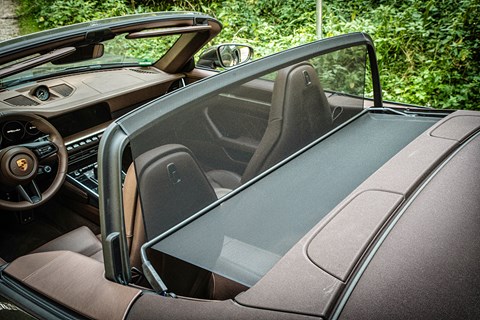
Any clever stuff?
Rear-wheel steering was introduced to the 911 Turbo in 2019, and so was a significantly more digital infotainment and safety hub. All-wheel drive and the Sport Chrono pack are standard on 911 Turbos, but feistier brakes, fancier wheels, various chassis upgrades and a long list of colour and trim options are available too. The wind deflector behind the front seats is simple, clever and effective – just press a button and there it is.
Which version is this?
If it’s the body you’re after, the 911 Cabriolet range starts at £99,800 with the 380bhp Carrera, and goes via 4, S, 4S, GTS, 4 GTS and our Turbo to the £178,900, 641bhp Turbo S. The Carrera is a fine car – true, its performance won’t set the world alight like the Turbo, yet it sports the same impeccable convertible roof and very similar driving characteristics at £60k less than our test car.
Read our 911 Cabriolet review
Air Force Two: SL vs 911
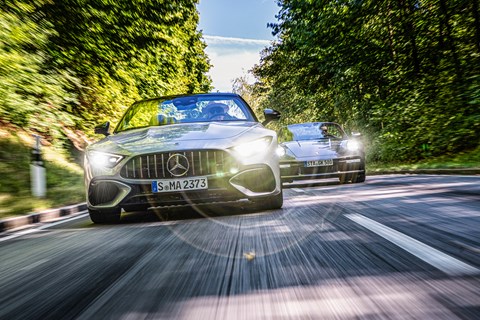
I was hugely impressed by the SL55 I drove in California in the February 2022 issue, but concluded it was still a cruiser more than a sports car. So let’s see what the range-topping 63 can do, up against the only benchmark that matters, the Porsche 911 Turbo Cabriolet.
And not just any old 911 Turbo Cabrio. This is my own car, which replaced my four-year-old 911 GT3 Touring when I turned 70 earlier this year. Whereas a test car borrowed from Porsche may well have come with a stack of extras – carbon ceramic brakes, titanium exhaust and a glut of assistance systems – this vision of a close-to-perfect high-end 911 convertible keeps it relatively simple.
It costs £157,400 (plus five grand of extras), against the SL63 at £179,225 in Performance trim. The only other trim available with the 63 is Premium Plus, at £171,725. In both cases, the Merc is pretty lavish compared to the Porsche, but don’t think of it as a big softy: it also has more power and more torque.
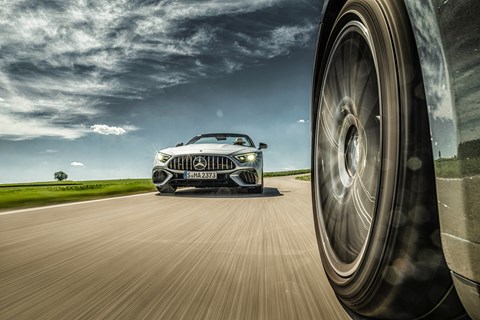
Is that what it takes to match the Porsche? Chasing the 911 has long been a matter of honour and pride for Germany’s car makers. The Audi R8, BMW M8 and – until recently – the Mercedes-AMG GT have all tried their best in pursuit of Zuffenhausen’s finest. The SL has been around since 1954 – since before the 911 was called the 911 – but it’s only really now, with this AMG-developed eighth generation, that it’s turned its sights directly on the 911.
This new SL echoes the Porsche in having a pair of token rear seats as standard and a power-operated canvas roof instead of the old retractable hardtop. It also, like the 911 Turbo, has all-wheel-drive and rear-wheel steering.
The favoured engine layout is, in both cases, familiar. While the V8 is still AMG’s engine of choice, the flat-six remains Porsche’s most charismatic kraftwerk. Although the V8 shrinks from 5.5 to 4.0 litres, the power output remains unchanged at 577bhp. Redlined at 7000rpm, the rev-hungry 3.8-litre Porsche six musters 572bhp, but the V8 wins the torque duel by 590lb ft at 2500rpm against 553lb ft at 2250rpm. The top-speed trial turns out to be a 196 vs 199mph near-dead heat. But the Porsche’s weight advantage of 1710 vs 1970kg helps the 911 out-accelerate its competitor by 2.9 against 3.6sec over the 0-62mph run.

When it’s not trying to be a 911, what exactly is it that makes an SL an SL? Back in 1954, the Super Lightweight name made sense, although that’s certainly not a defining characteristic of this car. But greatness is rarely down to one outstanding strength – what matters more is the intelligent mix of seasoned and fresh virtues. There was not much to be learned from the pretty but dynamically frustrating 190SL, but the pagoda-roofed W113 oozed elegance and style, and those qualities are among the cornerstones of the 2022 model. The R107 was a huge success because it fused status, quality and punch – just like the current car does (while also throwing in a bunch of high-tech innovations). The generations that followed foreshadowed today’s overkill complexity, with trick chassis set-ups, a V12, up to three different AMG versions, that polarising folding hardtop, excess bling and increasingly bloated dimensions.
The new SL is to an extent a back-to-its-roots roadster, but one that’s picked up some other ideas along the way. The aggressive-looking nose is clearly inspired by the AMG GT, while the rounded rear end mimics the 911. Its sole obvious aero aid is a four-stage rear wing.
Similarly, the Porsche largely adheres to 911 Turbo tradition, but not exclusively; apart from the bespoke aprons, the wider stance and the trademark lateral air intakes, the Turbo does not differ all that much from the GTS. Inside, more equipment is standard, but goodies like sound by Burmester, extra leather and Innodrive predictive cruise control are optional.
In the Mercedes, the many assistance systems are back in action as soon as you restart the engine. In the Porsche, one stab at the appropriate button puts them to rest for good.
On our Californian introduction to the new SL we were smitten by the car’s tenacious grip, riveting carbon-ceramic brakes, flat and failsafe cornering prowess and awesome midrange punch. All these positives still hold true after the second encounter with the SL, which rights many of the wrongs of previous generations.
Steering? The vagueness around the straight-ahead position is no more, while turn-in is fast but not snappy, and at 1.75 turns from lock to lock the helm is super-reactive putty in your hands. The rear-wheel-steering system does its job unobtrusively. Having said all that, the turning circle should be tighter than 12.3 metres, the self-centring effort could be a little more energetic through the twisties, and the unnecessarily fat-rimmed steering wheel is laden with more features and functions than most digits can master.
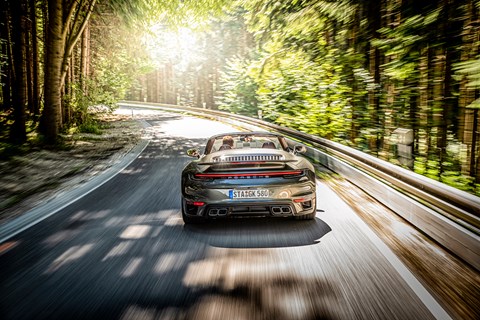
At 38 against 62 per cent, the Turbo is a tail-heavy beast. The portlier Benz allows 54.1 per cent of the weight to rest on the front axle. This beats the previous generation by a small sack of potatoes but can’t match the discontinued AMG GT Roadster’s 48 to 52 per cent poise. Which takes us right to the heart of the matter. While the GT MkI was a bespoke sports car, the new SL is a genetic mix of E63 S 4Matic+ elements and the new, aluminium-intensive MSA matrix which will also underpin the second-generation GT due (as a coupe only) next year. The GT’s unique transaxle, which made all the tactile and tangible difference, bites the dust.
The AMG SL63 includes double wishbones all-round, adaptive dampers, four hydraulic anti-roll actuators and a rear diff lock. The Porsche also comes with adjustable shock absorbers, but I refrained from specifying the lowered sports suspension and the weighty active anti-roll device PDCC.
Putting a combined 1149bhp and 1143lb ft to the test in summertime in Upper Bavaria involves a lot of things that are best avoided: cyclists racing in a throng, ponderous mobile homes cruising at 45mph, motorcyclists chancing their luck on the wrong side of the road, hire cars with stuttering sat-nav… The best way to avoid them is to aim for the hilly hinterland, which is much clearer, while not without hazards of its own: cattle, deer and huge tractors. It’s here in the Landsberg-Memmingen-Ulm-Augsburg loop where you can still pull out all the stops, but before we get there the westbound A96 autobahn beckons. It’s not so deserted that you can assume you’ll achieve sustained flat-out speeds, but it’s worth a try.
Going flat out is less stressful in the SL. The big silver speedboat hugs the road like a well oiled hypervelocity magnet. Tramlining can be an issue, but usually the front axle feels very firmly connected to the bleached and occasionally rippled tarmac. The steering weight is spot-on, steering response is brisk but not hectic, and minor course corrections are the exception, not the rule.
By design, the Porsche is somewhat less confidence-inspiring at speed, being more inclined to stray from the chosen line. The front suspension feels busier, the steering feedback over difficult turf is more agitated, and directional stability is less of a priority. Many newcomers are concerned by this underlying restlessness, but it does not take long to understand that the comparatively light front end will always – and I mean always – sort itself out. More often than not, driver inputs are redundant or even counter productive.
The Turbo does not track as stoically as the SL, but it tells a more colourful story and keeps adding fresh nuances to a wild ride, whereas the Mercedes starcruiser is ultimately less exciting. Rural roads showcase the Turbo’s finely honed handling talents, the seamless car-driver interaction, and the all-important quality of the flow; it’s this flow that defines the 911. The Turbo steers like a scalpel, not merely like a sharp knife. It dances like a faun along the ridge of adhesion rather than merely straddling it.

The Mercedes does not lag far behind at all. It is less involving, but the margin is small. Its actions and reactions are somewhat less precise and immediate; we’re talking minor gradations. It rides better than the Porsche, except at low speed and over rough undulations. The brakes are often excellent: easy to modulate, eager to please and stuffed with stamina.
It’s the little things that irritate the driver of the SL. The cheapo column-mounted transmission selector stalk doesn’t always engage the desired gear at the first attempt. The wide centre console and
the useless rear seats compromise legroom for tall drivers. The 11.9-inch touchscreen, a donation from the S-Class, is out of place in a self-proclaimed sports car. And while the Porsche packaging wizards managed to neatly integrate a pushbutton wind deflector, its multi-fold counterpart from AMG is a fiddly DIY job.
The sound engineers must have worked overtime on the latest eight-ender – the last AMG will ever drop into a new model. Depending on the selected drive mode, its repertoire includes wastegate hiss, turbo whine, lift-off blat-blat, full-throttle roar, goose-pimple intake rasp and repetitive rev-limiter staccato. This is combustion showmanship at its best and social acceptance at its most controversial.
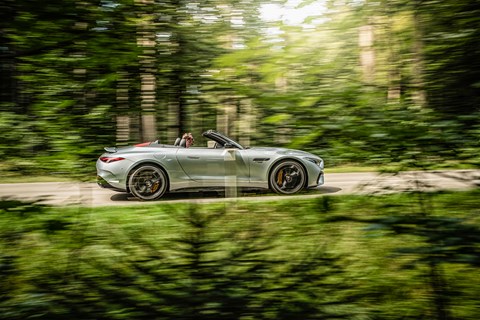
By comparison, the boxer engine sounds coarser when first fired, but the initially lumpy idle quickly evens out as the twin-turbo 3.8-litre unit starts laying an ever changing variety of sound carpets of different density and pile. Although both engine philosophies put an emphasis on low-end twist action, the V8 feels subjectively even beefier than the numerical advantage suggests.
The nine-speed automatic fitted to the Merc may make a difference to fuel consumption, but right now three overdrive ratios are two too many. Like in the Porsche, you need to be in Sport (not Comfort or Normal) to fully relish the forces on offer. While Sport+ is an overly restless calibration in the eight-speed 911, the Benz wows the hardcore faction with an even more radical Race set-up. ESP can in both cars be deactivated in two steps, and there are bespoke Wet (Porsche) and Ice (SL) programmes to mitigate treacherous driving conditions. In addition to all those different damper and drivetrain calibrations, AMG Dynamics lets you tweak the steering action, torque split and shift speed. Eight different instrument graphics reflect the full mood spectrum, from calm to chaos.
Mercedes-AMG SL63 vs Porsche 911 Turbo Cabriolet: the final reckoning
As I write, the waiting list for both models is one year, and growing. They’re not cheap, and much of the performance potential will be untapped, but there are plenty of people – me included – who find this sort of thing very appealing.
In the UK, the 911 Turbo Cabrio seems like a bargain at £157k when compared with the £179k asked for the open-air Mercedes. Even if you went down a Merc trim level from our car’s Performance to Premium Plus, and simultaneously hit the Porsche options list quite hard, the 911 would struggle to cost as much. In truth, though, money is rarely the decider in this league.
In which case, what about the other classic criteria? The 911 is quicker off the mark by 0.7sec, it is less heavy on fuel, and its build quality is faultless from bottom to top. The SL looks flashier as a whole and in detail, but some materials are of a lesser grade.
Sadly, the Merc’s packaging sucks: not enough room in the boot, not enough space in the back seats; it’s a compromise likely to please few. And while some may find the SL’s myriad digital features, functions and follies irresistible, others prefer the Porsche’s no-nonsense ergonomics.
Although this SL is more 911-like than its predecessors, it’s still very different. You sit relatively high up in the SL, while the front-mid engine layout trades a certain amount of cabin space for that sexy street-cred bonus, and with the roof up wind noise is an issue (one Mercedes is aware of, and says it will soon fix).
The 911 Turbo connects the driver to the road in a much more direct and intimate manner, and this total-fusion principle extends to the seats, the controls and the key dynamic interfaces. There is a directness to all motions which shouts loud and clear that the Porsche is the real sports car here, not just a very fast and gaudy two-seater ragtop.
True, it’s harder work to go ten tenths in the 911, especially on a wet and windy day on a country road with a neglected surface. But it’s also more rewarding to relish the extra ounces of talent which must be unearthed afresh every time you don those old racing gloves.
The silver arrow is a thoroughly convincing effort, yet the green car wins on overall merit. Having said that, a low-mileage AMG GT C Roadster and a base Carrera convertible could be intriguing and much more affordable alternatives…
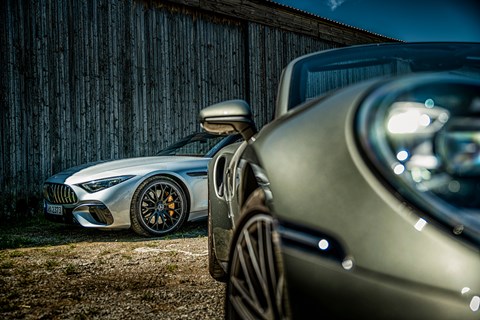
Mercedes-AMG SL63 vs Porsche 911 Turbo Cabriolet: the verdict
1st
Porsche 911 Turbo Cabriolet
Sparsely equipped and expensive, the Turbo is better balanced than the GTS and barely less fast than the Turbo S. It out-handles and out-dazzles the SL
2nd
Mercedes-AMG SL63
Great car for showing off and covering long distances in style, but the ill-packaged Merc is not a thoroughbred like the 911